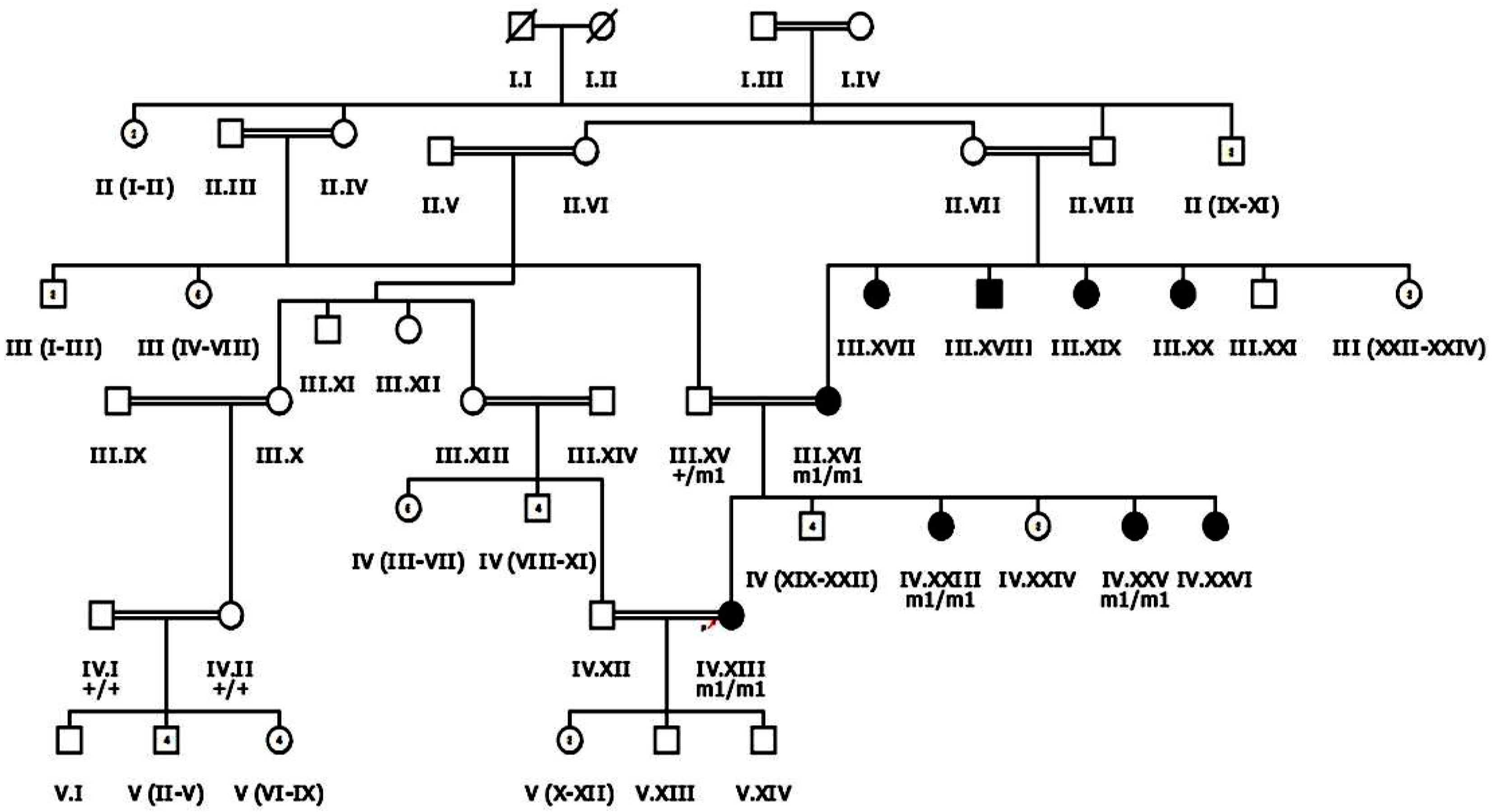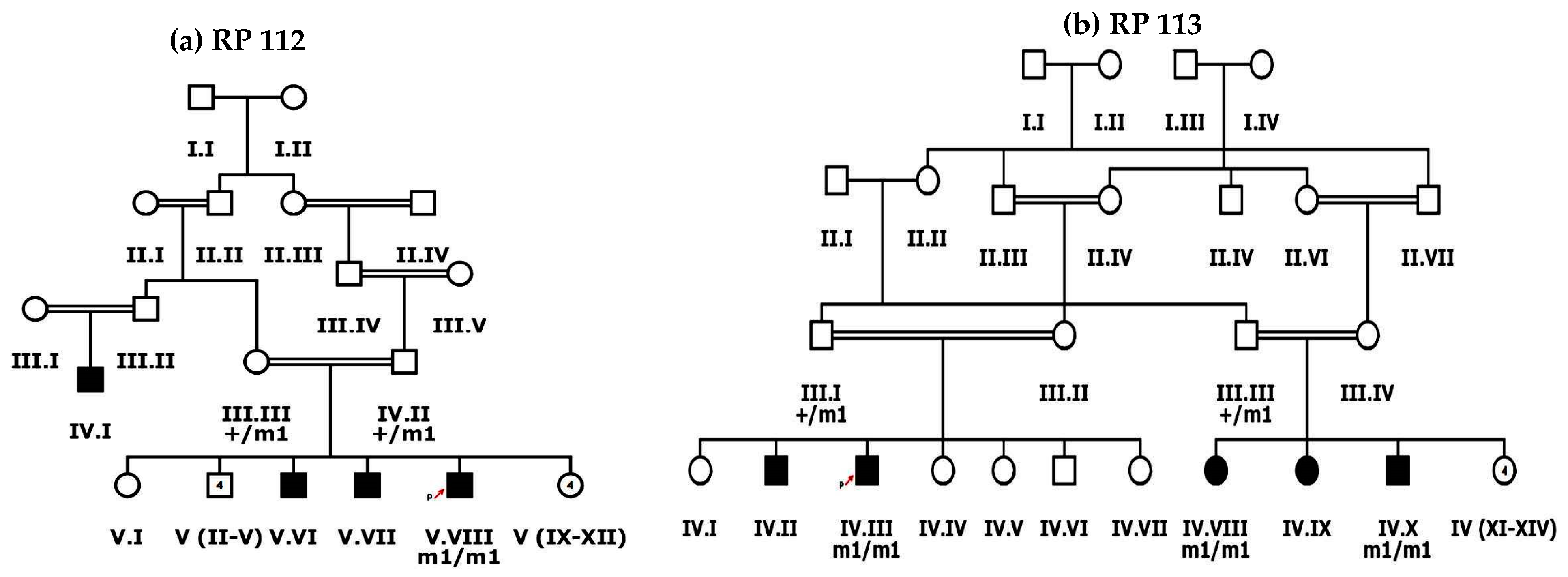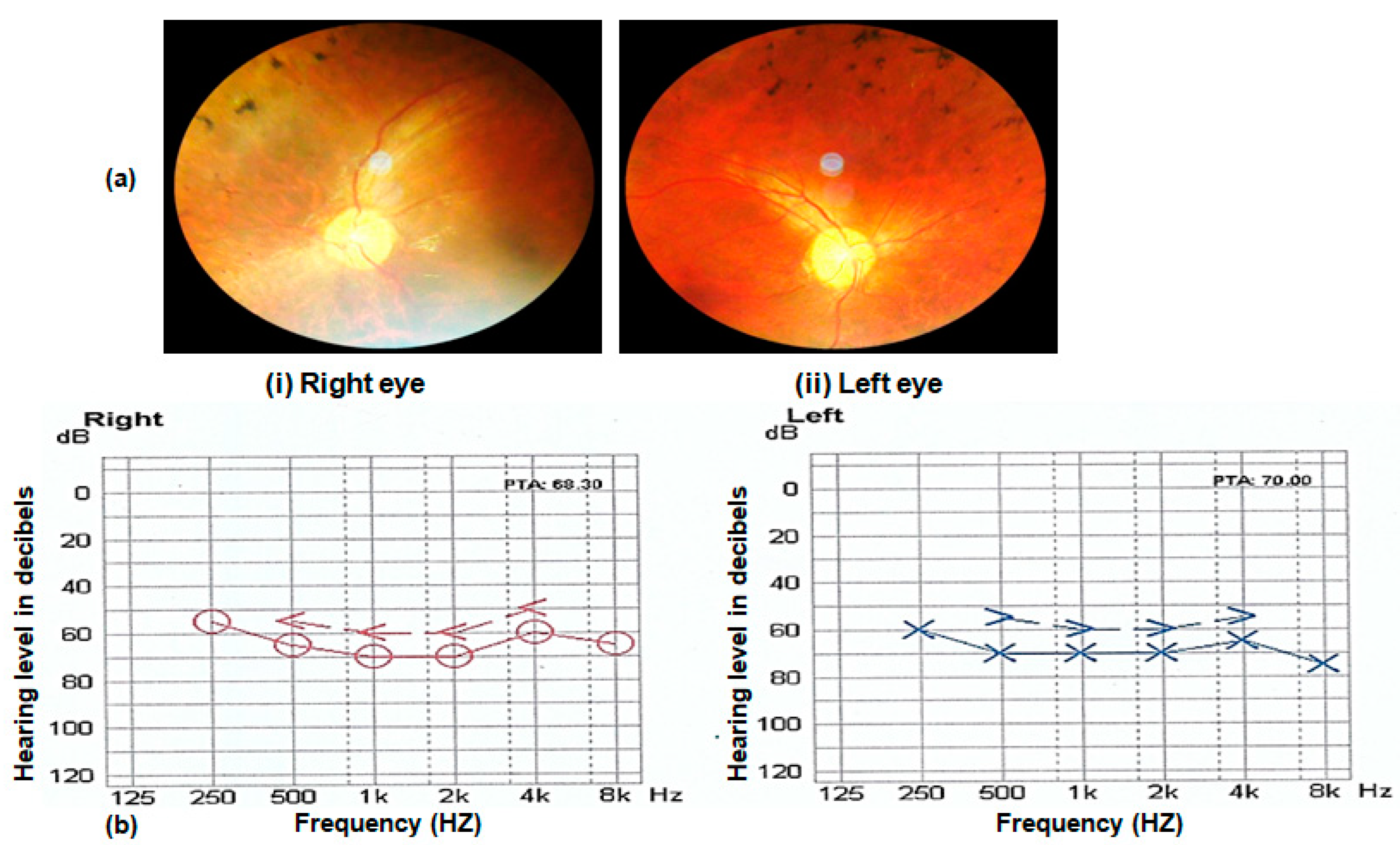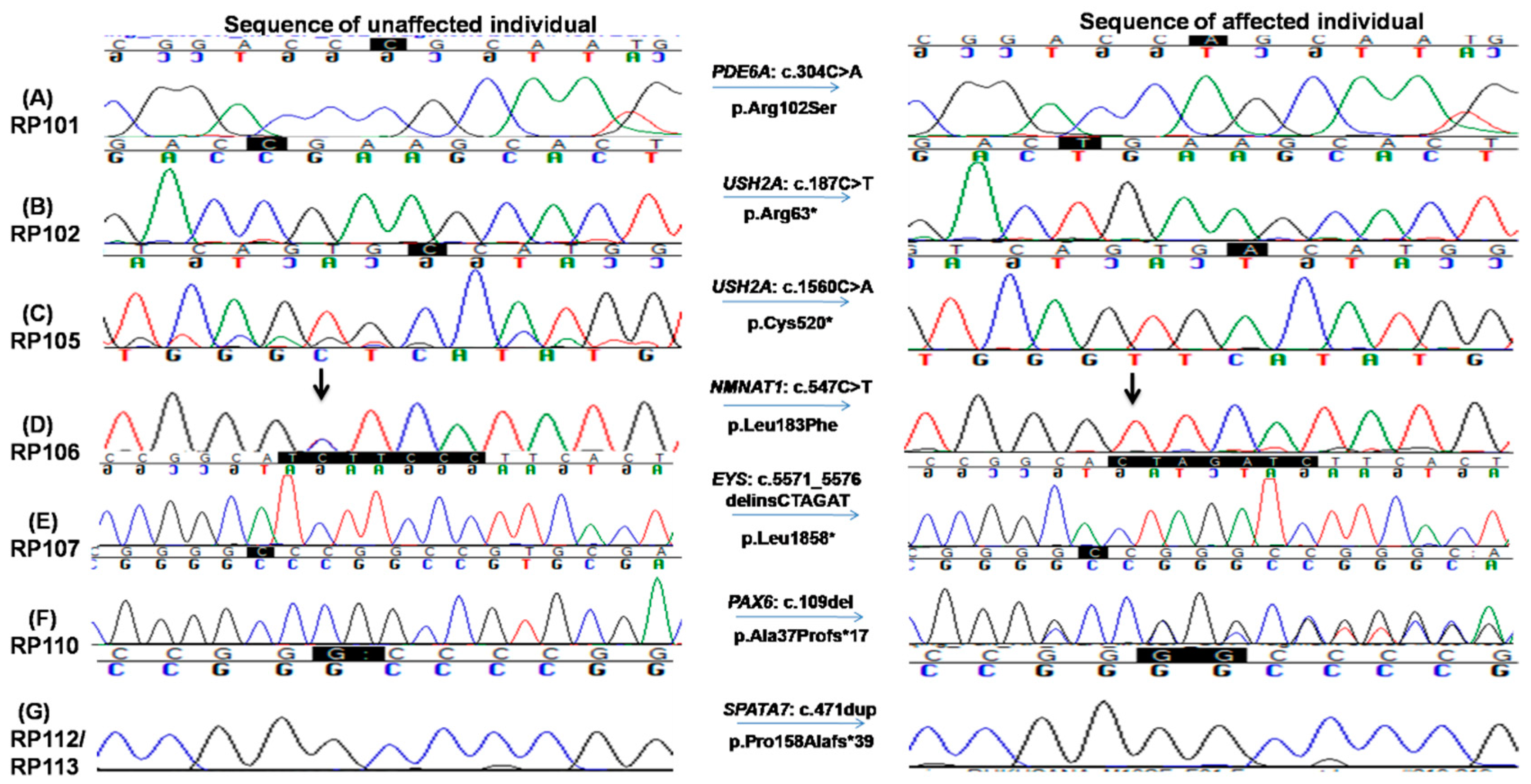Exome Sequencing Identified Molecular Determinants of Retinal Dystrophies in Nine Consanguineous Pakistani Families
Abstract
:1. Introduction
2. Materials and Methods
2.1. Enrollment of Patients for Study
2.2. Sample Collection, DNA Extraction and Targeted Exome Sequencing
2.3. Bioinformatics Analysis
2.4. Sanger’s Validation and Segregation Test
3. Results
4. Discussion
Supplementary Materials
Author Contributions
Funding
Institutional Review Board Statement
Informed Consent Statement
Data Availability Statement
Acknowledgments
Conflicts of Interest
References
- Verbakel, S.K.; van Huet, R.A.; Boon, C.J.; den Hollander, A.I.; Collin, R.W.; Klaver, C.C.; Hoyng, C.B.; Roepman, R.; Klevering, B.J. Non-syndromic retinitis pigmentosa. Prog. Retin. Eye Res. 2018, 66, 157–186. [Google Scholar] [CrossRef] [PubMed]
- Hamel, C. Retinitis pigmentosa. Orphanet J. Rare Dis. 2006, 1, 40. [Google Scholar] [CrossRef] [PubMed]
- Musarella, M.A.; MacDonald, I.M. Current concepts in the treatment of retinitis pigmentosa. J. Ophthalmol. 2011, 2011, 753547. [Google Scholar] [CrossRef]
- Sen, P.; Bhargava, A.; George, R.; Ramesh, S.V.; Hemamalini, A.; Prema, R.; Kumaramanickavel, G.; Vijaya, L. Prevalence of retinitis pigmentosa in South Indian population aged above 40 years. Ophthalmic Epidemiol. 2008, 15, 279–281. [Google Scholar] [CrossRef] [PubMed]
- Na, K.-H.; Kim, H.J.; Kim, K.H.; Han, S.; Kim, P.; Hann, H.J.; Ahn, H.S. Prevalence, age at diagnosis, mortality, and cause of death in Retinitis Pigmentosa in Korea—A nationwide population-based study. Am. J. Ophthalmol. 2017, 176, 157–165. [Google Scholar] [CrossRef]
- Daiger, S.P.; Bowne, S.J.; Sullivan, L.S. Perspective on genes and mutations causing retinitis pigmentosa. Arch. Ophthalmol. 2007, 125, 151–158. [Google Scholar] [CrossRef] [PubMed]
- Koenekoop, R.K. An overview of Leber congenital amaurosis: A model to understand human retinal development. Surv. Ophthalmol. 2004, 49, 379–398. [Google Scholar] [CrossRef]
- Hanein, S.; Perrault, I.; Gerber, S.; Tanguy, G.; Hamel, C.; Dufier, J.-L.; Rozet, J.-M.; Kaplan, J. Amaurose congénitale de Leber: Le point sur l’hétérogénéité génétique, actualisation de la définition clinique. J. Français D’ophtalmol. 2005, 28, 98–105. [Google Scholar] [CrossRef]
- Ferrari, S.; Di Iorio, E.; Barbaro, V.; Ponzin, D.; S Sorrentino, F.; Parmeggiani, F. Retinitis pigmentosa: Genes and disease mechanisms. Curr. Genom. 2011, 12, 238–249. [Google Scholar]
- Dryja, T.P.; Adams, S.M.; Grimsby, J.L.; McGee, T.L.; Hong, D.-H.; Li, T.; Andréasson, S.; Berson, E.L. Null RPGRIP1 alleles in patients with Leber congenital amaurosis. Am. J. Hum. Genet. 2001, 68, 1295–1298. [Google Scholar] [CrossRef]
- Gerber, S.; Perrault, I.; Hanein, S.; Barbet, F.; Ducroq, D.; Ghazi, I.; Martin-Coignard, D.; Leowski, C.; Homfray, T.; Dufier, J.-L. Complete exon-intron structure of the RPGR-interacting protein (RPGRIP1) gene allows the identification of mutations underlying Leber congenital amaurosis. Eur. J. Hum. Genet. 2001, 9, 561–571. [Google Scholar] [CrossRef] [PubMed]
- Falk, M.J.; Zhang, Q.; Nakamaru-Ogiso, E.; Kannabiran, C.; Fonseca-Kelly, Z.; Chakarova, C.; Audo, I.; Mackay, D.S.; Zeitz, C.; Borman, A.D. NMNAT1 Mutations Cause Leber Congenital Amaurosis. Nat. Genet. 2012, 44, 1040–1045. [Google Scholar] [CrossRef] [PubMed]
- Den Hollander, A.I.; Roepman, R.; Koenekoop, R.K.; Cremers, F.P. Leber congenital amaurosis: Genes, proteins and disease mechanisms. Prog. Retin. Eye Res. 2008, 27, 391–419. [Google Scholar] [CrossRef] [PubMed]
- Zafar, S.; Ahmed, K.; Ali, A.; Baig, R. Retinitis pigmentosa genes implicated in South Asian populations: A systematic review. J. Pak. Med. Assoc. 2017, 67, 1734. [Google Scholar]
- Daiger, S.; Sullivan, L.; Bowne, S. Genes and mutations causing retinitis pigmentosa. Clin. Genet. 2013, 84, 132–141. [Google Scholar] [CrossRef]
- Priya, S.; Nampoothiri, S.; Sen, P.; Sripriya, S. Bardet–Biedl syndrome: Genetics, molecular pathophysiology, and disease management. Indian J. Ophthalmol. 2016, 64, 620. [Google Scholar] [CrossRef]
- Dreyer, B.; Brox, V.; Tranebjærg, L.; Rosenberg, T.; Sadeghi, A.M.; Möller, C.; Nilssen, Ø. Spectrum of USH2A mutations in Scandinavian patients with Usher syndrome type II. Hum. Mutat. 2008, 29, 451. [Google Scholar] [CrossRef] [PubMed]
- Ebermann, I.; Scholl, H.P.; Issa, P.C.; Becirovic, E.; Lamprecht, J.; Jurklies, B.; Millán, J.M.; Aller, E.; Mitter, D.; Bolz, H. A novel gene for Usher syndrome type 2: Mutations in the long isoform of whirlin are associated with retinitis pigmentosa and sensorineural hearing loss. Hum. Genet. 2007, 121, 203–211. [Google Scholar] [CrossRef]
- Weston, M.D.; Luijendijk, M.W.; Humphrey, K.D.; Möller, C.; Kimberling, W.J. Mutations in the VLGR1 gene implicate G-protein signaling in the pathogenesis of Usher syndrome type II. Am. J. Hum. Genet. 2004, 74, 357–366. [Google Scholar] [CrossRef]
- Bademci, G.; Foster, J.; Mahdieh, N.; Bonyadi, M.; Duman, D.; Cengiz, F.B.; Menendez, I.; Diaz-Horta, O.; Shirkavand, A.; Zeinali, S. Comprehensive analysis via exome sequencing uncovers genetic etiology in autosomal recessive nonsyndromic deafness in a large multiethnic cohort. Genet. Med. 2016, 18, 364–371. [Google Scholar] [CrossRef] [PubMed]
- French, L.S.; Mellough, C.B.; Chen, F.K.; Carvalho, L.S. A review of gene, drug and cell-based therapies for Usher syndrome. Front. Cell. Neurosci. 2020, 14, 183. [Google Scholar] [CrossRef] [PubMed]
- World Medical Association. World Medical Association Declaration of Helsinki: Ethical principles for medical research involving human subjects. JAMA 2013, 310, 2191–2194. [Google Scholar] [CrossRef] [PubMed] [Green Version]
- Wang, F.; Wang, H.; Tuan, H.-F.; Nguyen, D.H.; Sun, V.; Keser, V.; Bowne, S.J.; Sullivan, L.S.; Luo, H.; Zhao, L. Next generation sequencing-based molecular diagnosis of retinitis pigmentosa: Identification of a novel genotype-phenotype correlation and clinical refinements. Hum. Genet. 2014, 133, 331–345. [Google Scholar] [CrossRef] [PubMed]
- Thiele, H.; Nürnberg, P. HaploPainter: A tool for drawing pedigrees with complex haplotypes. Bioinformatics 2005, 21, 1730–1732. [Google Scholar] [CrossRef]
- Kaul, H.; Riazuddin, S.A.; Shahid, M.; Kousar, S.; Butt, N.H.; Zafar, A.U.; Khan, S.N.; Husnain, T.; Akram, J.; Hejtmancik, J.F. Autosomal recessive congenital cataract linked to EPHA2 in a consanguineous Pakistani family. Mol. Vis. 2010, 16, 511. [Google Scholar]
- Nikopoulos, K.; Butt, G.; Farinelli, P.; Mudassar, M.; Domènech-Estévez, E.; Samara, C.; Kausar, M.; Masroor, I.; Chrast, R.; Rivolta, C. A large multiexonic genomic deletion within the ALMS1 gene causes Alström syndrome in a consanguineous Pakistani family. Clin. Genet. 2016, 89, 510–511. [Google Scholar] [CrossRef]
- Dryja, T.P.; Rucinski, D.E.; Chen, S.H.; Berson, E.L. Frequency of mutations in the gene encoding the α subunit of rod cGMP-phosphodiesterase in autosomal recessive retinitis pigmentosa. Investig. Ophthalmol. Vis. Sci. 1999, 40, 1859–1865. [Google Scholar]
- Maria, M.; Ajmal, M.; Azam, M.; Waheed, N.K.; Siddiqui, S.N.; Mustafa, B.; Ayub, H.; Ali, L.; Ahmad, S.; Micheal, S. Homozygosity mapping and targeted sanger sequencing reveal genetic defects underlying inherited retinal disease in families from pakistan. PLoS ONE 2015, 10, e0119806. [Google Scholar] [CrossRef]
- Dreyer, B.; Tranebjærg, L.; Rosenberg, T.; Weston, M.D.; Kimberling, W.J.; Nilssen, Ø. Identification of novel USH2A mutations: Implications for the structure of USH2A protein. Eur. J. Hum. Genet. 2000, 8, 500–506. [Google Scholar] [CrossRef]
- González-del Pozo, M.; Martín-Sánchez, M.; Bravo-Gil, N.; Méndez-Vidal, C.; Chimenea, Á.; Rodríguez-de la Rúa, E.; Borrego, S.; Antiñolo, G. Searching the second hit in patients with inherited retinal dystrophies and monoallelic variants in ABCA4, USH2A and CEP290 by whole-gene targeted sequencing. Sci. Rep. 2018, 8, 13312. [Google Scholar] [CrossRef]
- Grønskov, K.; Olsen, J.H.; Sand, A.; Pedersen, W.; Carlsen, N.; Jylling, A.; Lyngbye, T.; Brøndum-Nielsen, K.; Rosenberg, T. Population-based risk estimates of Wilms tumor in sporadic aniridia. Hum. Genet. 2001, 109, 11–18. [Google Scholar] [CrossRef]
- Audo, I.; Sahel, J.A.; Mohand-Saïd, S.; Lancelot, M.E.; Antonio, A.; Moskova-Doumanova, V.; Nandrot, E.F.; Doumanov, J.; Barragan, I.; Antinolo, G. EYS is a major gene for rod-cone dystrophies in France. Hum. Mutat. 2010, 31, E1406–E1435. [Google Scholar] [CrossRef] [PubMed]
- Ur Rehman, A.; Peter, V.G.; Quinodoz, M.; Rashid, A.; Khan, S.A.; Superti-Furga, A.; Rivolta, C. Exploring the genetic landscape of retinal diseases in North-Western Pakistan reveals a high degree of autozygosity and a prevalent founder mutation in ABCA4. Genes 2019, 11, 12. [Google Scholar] [CrossRef] [PubMed]
- Shivanna, M.; Anand, M.; Chakrabarti, S.; Khanna, H. Ocular Ciliopathies: Genetic and mechanistic insights into developing therapies. Curr. Med. Chem. 2019, 26, 3120–3131. [Google Scholar] [CrossRef] [PubMed]
- Mackay, D.S.; Ocaka, L.A.; Borman, A.D.; Sergouniotis, P.I.; Henderson, R.H.; Moradi, P.; Robson, A.G.; Thompson, D.A.; Webster, A.R.; Moore, A.T. Screening of SPATA7 in patients with Leber congenital amaurosis and severe childhood-onset retinal dystrophy reveals disease-causing mutations. Investig. Ophthalmol. Vis. Sci. 2011, 52, 3032–3038. [Google Scholar] [CrossRef]
- Ullah, I.; Kabir, F.; Gottsch, C.B.S.; Naeem, M.A.; Guru, A.A.; Ayyagari, R.; Khan, S.N.; Riazuddin, S.; Akram, J.; Riazuddin, S. Mutations in phosphodiesterase 6 identified in familial cases of retinitis pigmentosa. Hum. Genome Var. 2016, 3, 16036. [Google Scholar] [CrossRef]
- Ng, T.K.; Tang, W.; Cao, Y.; Chen, S.; Zheng, Y.; Xiao, X.; Chen, H. Whole exome sequencing identifies novel USH2A mutations and confirms Usher syndrome 2 diagnosis in Chinese retinitis pigmentosa patients. Sci. Rep. 2019, 9, 5628. [Google Scholar] [CrossRef]
- Perez-Carro, R.; Blanco-Kelly, F.; Galbis-Martinez, L.; Garcia-Garcia, G.; Aller, E.; Garcia-Sandoval, B.; Minguez, P.; Corton, M.; Mahillo-Fernandez, I.; Martin-Merida, I. Unravelling the pathogenic role and genotype-phenotype correlation of the USH2A p.(Cys759Phe) variant among Spanish families. PloS ONE 2018, 13, e0199048. [Google Scholar] [CrossRef]
- Dad, S.; Rendtorff, N.D.; Tranebjærg, L.; Grønskov, K.; Karstensen, H.G.; Brox, V.; Nilssen, Ø.; Roux, A.F.; Rosenberg, T.; Jensen, H. Usher syndrome in Denmark: Mutation spectrum and some clinical observations. Mol. Genet. Genom. Med. 2016, 4, 527–539. [Google Scholar] [CrossRef]
- Sodi, A.; Mariottini, A.; Passerini, I.; Murro, V.; Tachyla, I.; Bianchi, B.; Menchini, U.; Torricelli, F. MYO7A and USH2A gene sequence variants in Italian patients with Usher syndrome. Mol. Vis. 2014, 20, 1717. [Google Scholar] [PubMed]
- Zupan, A.; Fakin, A.; Battelino, S.; Jarc-Vidmar, M.; Hawlina, M.; Bonnet, C.; Petit, C.; Glavač, D. Clinical and haplotypic variability of Slovenian USH2A patients homozygous for the c. 11864G>A nonsense mutation. Genes 2019, 10, 1015. [Google Scholar] [CrossRef] [PubMed]
- Weston, M.; Eudy, J.D.; Fujita, S.; Yao, S.-F.; Usami, S.; Cremers, C.; Greenburg, J.; Ramesar, R.; Martini, A.; Moller, C. Genomic structure and identification of novel mutations in usherin, the gene responsible for Usher syndrome type IIa. Am. J. Hum. Genet. 2000, 66, 1199–1210. [Google Scholar] [CrossRef]
- McGee, T.L.; Seyedahmadi, B.J.; Sweeney, M.O.; Dryja, T.P.; Berson, E.L. Novel mutations in the long isoform of the USH2A gene in patients with Usher syndrome type II or non-syndromic retinitis pigmentosa. J. Med. Genet. 2010, 47, 499–506. [Google Scholar] [CrossRef] [PubMed]
- Lenassi, E.; Vincent, A.; Li, Z.; Saihan, Z.; Coffey, A.J.; Steele-Stallard, H.B.; Moore, A.T.; Steel, K.P.; Luxon, L.M.; Héon, E. A detailed clinical and molecular survey of subjects with nonsyndromic USH2A retinopathy reveals an allelic hierarchy of disease-causing variants. Eur. J. Hum. Genet. 2015, 23, 1318–1327. [Google Scholar] [CrossRef] [Green Version]
- Monzó, C.; Gimeno-Ferrer, F.; García, J.C.F.; Amadoz, A.; Albuquerque, D.; Angueira, F.B.; Marcaida, G.; Rodríguez-López, R. Alström syndrome caused by deletion in ALMS1 gene fixed in a Northern Pakistan recurrent haplotype. Indian J. Case Rep. 2017, 3, 171–174. [Google Scholar] [CrossRef]
- Lagali, N.; Wowra, B.; Fries, F.N.; Latta, L.; Moslemani, K.; Utheim, T.P.; Wylegala, E.; Seitz, B.; Käsmann-Kellner, B. PAX6 mutational status determines aniridia-associated keratopathy phenotype. Ophthalmology 2020, 127, 273–275. [Google Scholar] [CrossRef] [PubMed]
- Khan, A.O.; Aldahmesh, M.A.; Alkuraya, F.S. Genetic and genomic analysis of classic aniridia in Saudi Arabia. Mol. Vis. 2011, 17, 708. [Google Scholar] [PubMed]
- Lima Cunha, D.; Arno, G.; Corton, M.; Moosajee, M. The spectrum of PAX6 mutations and genotype-phenotype correlations in the eye. Genes 2019, 10, 1050. [Google Scholar] [CrossRef] [Green Version]




| Family ID | Proband ID | Age of Onset | Age at Enrollment | No of Affecteds | Consanguinity | Family History | Disease Progression | Symptoms |
|---|---|---|---|---|---|---|---|---|
| RP 101 | III.IV | By birth | 41 years | 5 | YES | Positive | Stationary | Night blind |
| RP102 | IV.I | 9 years | 40 years | 3 | YES | Positive | Progressive | Night blind, Hearing loss |
| RP105 | V.IV | 14 years | 26 Years | 3 | YES | Positive | Progressive | Night blind, Myopia, Hearing loss |
| RP106 | V.II | By birth | 7 Years | 6 | YES | Positive | Stationary | Night blind, Uncontrolled body movements |
| RP107 | IV.XIII | 12 years | 30 years | 9 | YES | Positive | Progressive | Night blind, Epiphora, Myopia, Blurred vision |
| RP109 | IV.I | 2–6 years | 15 years | 3 | YES | Positive | Progressive | Night blind, Nystagmus, Hearing problem, Poor day vision |
| RP110 | V.IV | By birth | 32 years | 5 | YES | Positive | Progressive | Night blind, Photosensitive, Nystagmus, Poor day vision |
| RP112 | V.VIII | By birth | 45 years | 4 | YES | Positive | Progressive | Night blind, Maculopathy |
| RP113 | IV.III | By birth | 22 years | 5 | YES | Positive | Progressive | Night blind, Maculopathy |
| Family ID | Disease | NM_ID | cDNA Change | Protein Change | Gene | Genotype Status | Allele Type | Reference | ACMG Prediction |
|---|---|---|---|---|---|---|---|---|---|
| RP 101 | RP | NM_000440 | c.304C>A | p.Arg102Ser | PDE6A | Homozygous | Known missense | [27,28] | Likely Pathogenic |
| RP102 | USH | NM_206933 | c.187C>T | p.Arg63 * | USH2A | Homozygous | Known stop-gain | [29] | Pathogenic |
| RP105 | USH | NM_206933 | c.1560C>A | p.Cys520 * | USH2A | Homozygous | Known stop-gain | [30] | Pathogenic |
| RP106 | LCA | NM_022787 | c.547C>T | p.Leu183Phe | NMNAT1 | Homozygous | Known missense | rs1337014971 | Likely Pathogenic |
| RP107 | RP | NM_001142800 | c.5571_5576delinsCTAGAT | p.Leu1858 * | EYS | Homozygous | Novel stop-gain | N/A | Pathogenic |
| RP109 | AS | NM_015120 | c.9911_11550del | p.Asn3306Lysfs *7 | ALMS1 | Homozygous | Known deletion | [26] | Pathogenic |
| RP110 | Aniridia | NM_001258465 | c.109del | p.Ala37Profs *17 | PAX6 | Heterozygous | Known frameshift | [31] | Pathogenic |
| RP112 | LCA | NM_001040428 | c.471dup | p.Pro158Alafs *39 | SPATA7 | Homozygous | Novel frameshift | N/A | Pathogenic |
| RP113 | LCA | NM_001040428 | c.471dup | p.Pro158Alafs *39 | SPATA7 | Homozygous | Novel frameshift | N/A | Pathogenic |
Publisher’s Note: MDPI stays neutral with regard to jurisdictional claims in published maps and institutional affiliations. |
© 2022 by the authors. Licensee MDPI, Basel, Switzerland. This article is an open access article distributed under the terms and conditions of the Creative Commons Attribution (CC BY) license (https://creativecommons.org/licenses/by/4.0/).
Share and Cite
Tehreem, R.; Chen, I.; Shah, M.R.; Li, Y.; Khan, M.A.; Afshan, K.; Chen, R.; Firasat, S. Exome Sequencing Identified Molecular Determinants of Retinal Dystrophies in Nine Consanguineous Pakistani Families. Genes 2022, 13, 1630. https://doi.org/10.3390/genes13091630
Tehreem R, Chen I, Shah MR, Li Y, Khan MA, Afshan K, Chen R, Firasat S. Exome Sequencing Identified Molecular Determinants of Retinal Dystrophies in Nine Consanguineous Pakistani Families. Genes. 2022; 13(9):1630. https://doi.org/10.3390/genes13091630
Chicago/Turabian StyleTehreem, Raeesa, Iris Chen, Mudassar Raza Shah, Yumei Li, Muzammil Ahmad Khan, Kiran Afshan, Rui Chen, and Sabika Firasat. 2022. "Exome Sequencing Identified Molecular Determinants of Retinal Dystrophies in Nine Consanguineous Pakistani Families" Genes 13, no. 9: 1630. https://doi.org/10.3390/genes13091630
APA StyleTehreem, R., Chen, I., Shah, M. R., Li, Y., Khan, M. A., Afshan, K., Chen, R., & Firasat, S. (2022). Exome Sequencing Identified Molecular Determinants of Retinal Dystrophies in Nine Consanguineous Pakistani Families. Genes, 13(9), 1630. https://doi.org/10.3390/genes13091630








